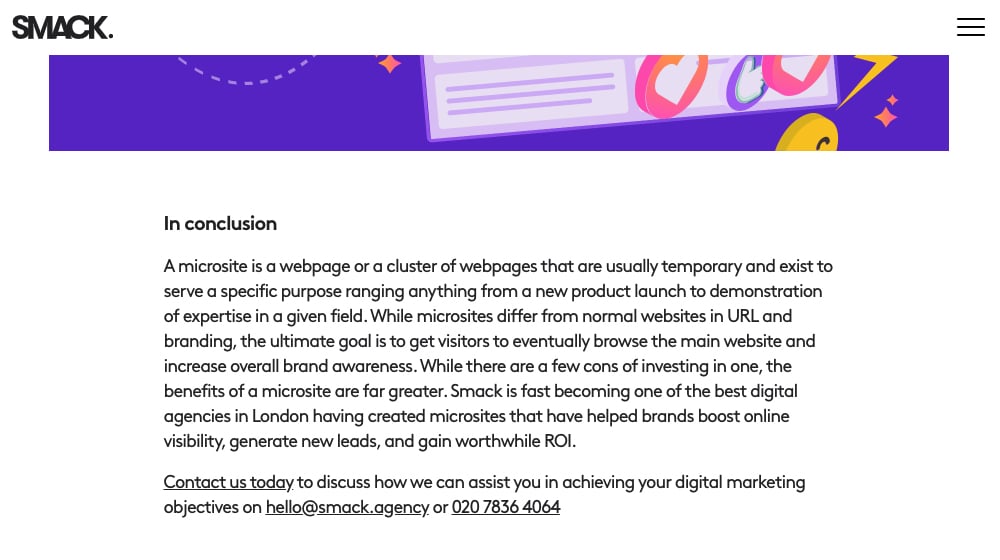What is a Microsite and Are They Worth Building for SEO?

Microsites are ancient SEO techniques that have existed for decades and have been used nonstop since they were invented, but they live in a nebulous gray area of value today. Do they work?
What do they do? Should you use them? I was curious, so I did some research.
What is a Microsite?
First of all, let's start with a definition. What even is a microsite, anyway?
Put simply; a microsite is a small website that you create to promote something related to your brand. It exists to rack up SEO value, be the landing page for advertising, and gather traffic from various sources that wouldn't usually find their way to your website. The microsite advertises for you and funnels traffic to your main blog while standing distinct from your primary site.

Microsites have a few key features.
- They use a different domain name from your primary site. For example, I have ContentPowered.com; I might make a microsite on PowerfulContent.com to advertise my content marketing services.
- They are generally temporary. They exist to be a landing page for an advertising or marketing campaign more than anything. As such, their SEO value isn't substantial, but their traffic may be.
- They host unique content. You don't simply syndicate your blog posts or your storefront over to a microsite; you create unique content for the microsite.
- They are generally small and focused. They are, after all, a microsite, not just another site. A microsite might be one single landing page or a small set of pages clustered around a single topic.
- They require a lot of dedicated effort to engineer. A microsite absolutely cannot work for you if you don't put in the groundwork for keyword research, user intent, advertising, linking, social media, and calls to action.
Microsites allow a brand to do something they couldn't do with their primary site.
Amazon, for example, is not going to throw large banners and advertising across their homepage to promote what is, likely, a deal only for a niche segment of their users. However, if they make a dedicated microsite for that purpose, they can focus advertising into that microsite specifically targeting that audience, without disrupting their main homepage.
What are the Benefits of a Microsite?
Microsites have a few definite benefits for brands that use them.
1. For one thing, they allow a brand to be creative and explore concepts, marketing techniques, branding, or other expressions of creativity that they otherwise cannot. Some brands use these to test out new ad campaigns, new branding, or new marketing techniques.
2. Another benefit is that they can be highly laser-focused on a particular subset of the brand's core audience. A typical example of this is brands creating dedicated LGBT+ pages. Or, consider if I wanted to attempt to attract many new clients in, say, real estate. I could make RealEstateContent.com and develop a landing page dedicated to that particular kind of client. It's a focus I can't give to ContentPowered.com because it would alienate non-real estate clients. But, with a microsite, I can aggressively market the microsite to real estate agencies, refer them back to ContentPowered.com to hook them as clients.

3. Microsites can also split off content that might be too popular. If you're about to launch a new product and want to give people an easy way to register for a waitlist but don't want to risk crashing your website with the traffic, you can set up a microsite with information and an opt-in on separate hosting from your own.
4. Microsites can also work as a distillation of your brand. A massive site like HubSpot could create a microsite that pares down all of the cruft of their leading site and focuses on just who they are, what they do, and their value proposition for their target audience, and nothing else.
These strategies all might sound similar to some other marketing techniques, which might give some of you pause.
Doesn't This Sound like a PBN?
A private blog network is a network of blogs, usually small sites without much content on them. Those sites exist to get content in a specific topic indexed and link back to the core domain of the person running the network.
A microsite is a website or small cluster of websites, usually small sites without a lot of content. These sites exist to get content in a specific topic indexed and refer traffic back to the core site of the brand running the microsite.
Are these not just the same thing?
Well, the truth is, while there are some similarities, they aren't the same at all.
A private blog network exists to funnel link juice towards a money domain while pretending to be unrelated. The core defining features of a PBN is that there's a lot of them and that they're isolated and hidden away. You register them using a protected domain registrar. You use different architecture, content, and structure for your primary site. You generally make it so that no one looking at it would ever realize you own it.

Then you make dozens more of them. Google picked up each one, given some small SEO value and funnels that value your leading site through links.
Microsites are similar in a way, except for two key components.
1. The first is that a microsite does not need to use links to value a brand. Microsites might exist to gather email opt-ins, form fills, or app downloads - they don't much care about backlinks or link juice.
2. The second is that a microsite is not hidden. You never hide your association with a microsite; in fact, they often still include all of your brandings clearly on the page. This association is what makes it a white hat technique rather than a black hat technique.

So, while the comparison to a PBN is superficially there, the two aren't the same thing at all.
The Issue of Microsite SEO
I've talked a lot about what a microsite is and what benefits it has, but one thing I haven't mentioned is the idea of SEO. And, since the topic of the post is the SEO of microsites, it's time to ask: are microsites a good technique for SEO?

People who like microsites for SEO tend to think of the internet like they would real estate. In a way, it makes sense, right? If you own one property, you can use that property to make money. If you own three properties, you can make more money by reaching different groups, offering various products, renting to varied groups of people, or what have you. Ostensibly, shouldn't the same be true of websites?
The truth is, no, not really. The internet isn't like real estate. All of the factors of SEO require investment and time.
- SEO requires time to build up value. I often say it takes 6-12 months to start getting traffic on a new site. Microsites are usually temporary and only last for 1-6 months, depending on their campaigns.
- SEO requires content. Old SEO worked with microsites because a site could be indexed and ranked based on a few pieces of content rather than on an aggregated idea of the value of the entire domain. Modern SEO is much more complex and rewards long-term investment, not short-term content.
- SEO requires continuity. You're building the SEO of your domain through all of your marketing efforts. A microsite isn't going to make much if you're keeping it small and narrowly focused.
Microsites aren't a valuable technique for SEO unless you plan to keep them around and invest in them.
What about the example I used above, making a real estate spinoff site to attract real estate clients and funnel them back here? That's an example of a long-term microsite option. I could create that site, put 5-10 blog posts on it, and publish a new post every 2-3 months, and it would work just fine.
The biggest problem with this is the effort put into the content. If it's good content, it could just go on my primary site. If it's not good enough to be on my site, it's not good enough to attract the clients I want to attract.
The key to this is that a microsite doesn't gather its traffic from SEO. It collects its traffic from social media promotion, paid ads, and viral word of mouth.
These issues are why I don't believe microsites are valuable for SEO purposes. Microsites have plenty of potential value, but they shouldn't be considered a realistic SEO growth technique.

There are a lot of brands out there who seem to love microsites. Usually, they're agencies that specialize in creating microsites, like Smack or BluLeadz. They talk about microsites as SEO feeders, and I don't see the value. All of the efforts you'd be spending on a microsite are better spent on your site, landing pages, and content marketing.
Should You Use a Microsite?
Should you use a microsite?
I don't think so unless you're a significant brand like Amazon and can benefit from setting up a narrowly-focused site for content that would otherwise get lost in the shuffle of constant commerce.
Then again, Amazon has the money and media coverage to do whatever they want and brute force success, so do they need microsites? Probably not, to be honest.
Let's talk about scenarios where you might want to use a microsite.
1. You want to create a cluster of content focusing on a specific niche within your overall subject to attract that particular kind of client. My real estate example is one example of this. Another might be an IT company creating a microsite for hotel security concerns, with content specific to hotel security and the physical and digital threats hotels face.
Should you use a microsite for this purpose?
Does this dilute your primary site? Not really. You would better spend that effort o
I write about PPC advertising; that doesn't mean people suddenly think I do PPC marketing or only do PPC.
It's just a way to attract users interested in that topic, which I can then convince them that they can benefit from content marketing.
2. You want to create a site that explores concerns that are only relevant to a subset of your audience.
For example, an automotive company could create a website exploring the impact of fossil fuel vehicles on the environment and how their changes reduce that impact. This topic is of great concern to environmentalists, but less so to people who want to buy a car, so it gets segmented off into a microsite.
Is this worthwhile?
Maybe, but it has value for informational, journalistic, and ethical reasons, not SEO. The microsite doesn't exist to convince people to buy a car; it exists to convince people that this car manufacturer is better than others. It's there to fuel reporting and be cited as a source, not to convert customers, at least not directly.
3. You want to go completely off the wall with experimental design, content, branding, colors, or other creative pursuits. If I wanted to experiment with animated content, video, or a color other than yellow, I could do it on a microsite instead of my primary site in case it doesn't work out.
Is this valuable?
The Short of It
It pretty much all comes down to is that microsites are an advertising technique, not an SEO technique.
Have you used a microsite before? How did it turn out? I'm curious if my analysis holds up to practical results or if I'm wrong and should start building some microsites. Honestly, I feel that effort is better to spend on my core site, but maybe one day, I'll get more value out of creating sub-sites instead.










April 26, 2022
Haven't tried it yet but I think I might! Hoping to get good results!
April 29, 2022
Hey Charm! Good luck; remember not to spread yourself too thin - having an army of sites sounds like a good idea at first, but your attention gets divided between them, and they can grow at a much slower rate (or not at all).